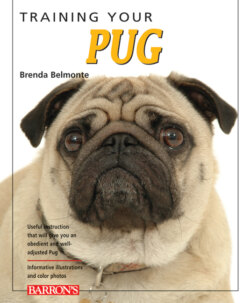Читать книгу Training Your Pug - Brenda Belmonte - Страница 10
На сайте Литреса книга снята с продажи.
Normal Canine Behaviors
ОглавлениеAll domestic dogs share a distant common ancestor: the wolf. The behaviors of wolves have been thoroughly studied and documented, with many books and movies available to learn about their social hierarchy, behavior patterns, and communication skills. While early domestication and the subsequent selective breeding by man produced dogs that vary widely in size, shape, and appearance, many of the behaviors attributed to the dog’s wild origin remain apparent even today. Dogs have a complex way of interacting within their own social group. The behaviors that are associated with normal canine interaction allow dogs to communicate and live comfortably within the same household without repeated problems or conflicts in most cases. These normal dog behaviors can become problematic for owners who do not understand them. Families that are not prepared to train their Pug may be unable to tolerate or change normal dog behaviors such as barking.
Pugs are a popular choice for many families.
Play Behaviors
Play behaviors are characterized by postures or vocal sounds that indicate a willingness to interact in a positive, playful manner. When young Pugs interact with human family members they often exhibit play behaviors as if they were playing with a littermate. Play behavior in dogs is one of social interaction and relationship building. The ability to play with other well-socialized dogs, accompanied by play with human family members, allows a puppy to learn problem-solving skills, provides necessary mental and physical stimulation, builds confidence, and teaches proper interaction skills.
Play Postures: The “play bow” is one of the most common body postures that a Pug uses to indicate a playful interaction. A Pug soliciting play will often drop onto his front legs, elbows on the floor, and subsequently lower his head, while keeping the rear end elevated, his tail uncurled and wagging during the display. This playful display may be accompanied by short, repetitive barking—the puppy’s verbal attempt to say, “Play with me!”
Pugs are also noted for running through a room full speed ahead, with their back arched and their tail tucked, spinning and barking. They may jump on toys during the “fit” or lunge out to bite at anyone or anything within reach. They will stop to bark and then resume the “Pug run,” seeming to gain momentum whenever their owners laugh at their antics. This behavior may seem unusual but it is a normal outlet for play energy in the Pug.
The play bow is your Pug’s way of saying “play with me!”
Play Biting: Play among puppies can include slamming into each other, chasing sequences, and biting—all of which are very normal play behaviors in dogs. They bite each other’s ears, tails, feet, and legs during playful interactions. A very bold puppy may pin a less confident playmate by the back of the neck, growling and shaking the skin as if to say, “I’m the boss!”
Pug puppies are no exception when it comes to using their teeth during play. Play biting is one of the most common complaints from their owners. With or without socks, unsuspecting human toes become a target, taking the place of a littermate’s ears and tail. Baggy clothing may also become a favorite plaything. Many Pug puppies also vocalize during play, growling whenever their teeth find something to sink into. Barking, growling, and biting can all be part of normal play routines, but these common canine behaviors are often misinterpreted as aggressive or dominant actions by their owners. When a Pug puppy presents itself in a play bow, barking in a high-pitched tone and then begins to engage in biting toes or clothing, he is exhibiting normal play behaviors. This may escalate to growling once he has hold of a pant leg. Behaviors such as these normally decrease over time as the puppy matures. Chapter 8 offers ways to minimize your Pug’s play biting.
Chewing
Dogs learn to explore their environments by observing their surroundings, using scent discrimination to investigate new objects, followed by an exploratory chew. If something warrants further investigation, a dog will often place the object in his mouth simply to find out what will happen. The chewing of objects satisfies a dog’s natural curiosity, and is a primal instinct carried on from a dog’s wild ancestors.
Chewing is a normal behavior for Pug puppies.
Chewing also serves as a means of relieving the discomfort caused by the eruption of puppy teeth. The desire to chew can also be an outlet for nervous or anxious behaviors, and is a normal way for a Pug to get rid of energy.
